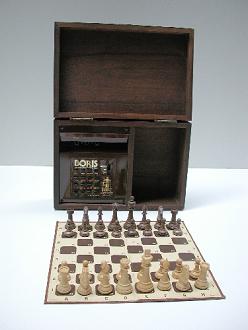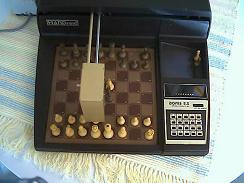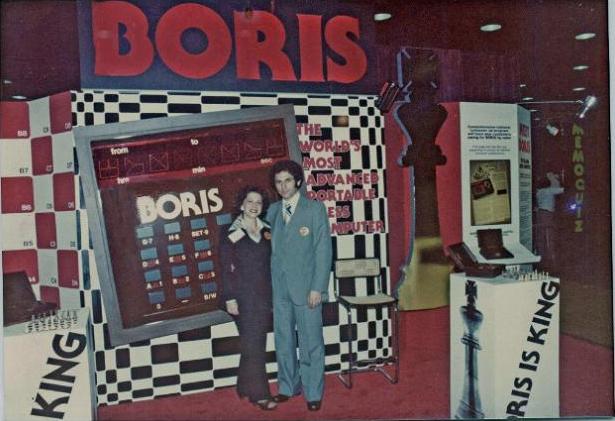Boris

Boris,
an early dedicated chess computer, which appeared in February 1978, designed and manufactured by Applied Concepts [2] and marketed by primary distributor Chafitz. Already in March 1978, Boris played Second West Coast Computer Faire Microcomputer Chess Tournament in the "microcomputers with less than 8K of memory class" [3]. Boris ran on a Fairchild F8 8-bit microprocessor with only 2.5 KiB ROM and 256 byte RAM. David Lindsay was hired to program the machine [4], and two further Boris models with Lindsay programs appeared in 1979, the first travel chess computer Boris Diplomat [5] [6], where Lindsay holds a patent [7] on the Chess piece font [8], and the Boris Master [9].
Contents
Photos
Arleen and Steve Chafitz, Boris is King [10] [11]
Bobby Fischer calling
Steve Chafitz on a call from Bobby Fischer [12] [13]:
Just to rewind a bit, one evening when I was home having dinner, I got a call from Bobby Fischer. He was excited about our electronic chess game "Boris" and I realized that if he was interested in our electronic chess game that there was a major market out there. We increased our development of electronic games and yes, we hired the brightest and the best programmers in the country to develop programs for our games.
The name of the computer was likely in dependence on the given name of Boris Spassky, who lost the Chess World Championship 1972 from Bobby Fischer in Reykjavik.
Co-Author
The ICGA site mentions Rex Kent as author of Boris Experimental which played the 1st World Microcomputer Chess Championship 1980 in London [14]. However, Boris X was already the work of Kathe and Dan Spracklen, and additionally with modifications by John Aker and Terry Fredrick. Rex Kent operated Boris at the PCW-MCC 1978 [15]. It is a bit unclear whether Kent was operator or co- or book-author of the early Boris otherwise credited to David Lindsay.
Boris 2.5
In 1979, following the development of the original Boris when more advanced programs were required, Arleen and Steve Chafitz contracted Kathe and Dan Spracklen to be their chess programmers for their Chafitz modular game system as well the Applied Concepts Great Game Machine [16]. Their Sargon 2.5 program appeared as Chafitz Sargon 2.5 MGS module [17], and in 1980, as Chafitz ARB Sargon 2.5 [18], also called Boris Sargon 2.5 [19] or simply dubbed Boris 2.5. John Aker and Terry Fredrick, affiliated with Applied Concepts, were involved in improving the Sargon and Boris program [20].
Boris Handroid

Boris Handroid was the first but very rare electronic chess robot from 1980 [22], with 64 Hall effect sensors to recognize pieces, and three servomechanisms to control the cartesian robotic arm. The Handroid program, adapted by Terry Fredrick [23] was also based on Sargon 2.5 by Kathe and Dan Spracklen.
Boris Experimental
Boris Experimental (Boris X) was the further development of the Boris 2.5 aka Sargon 2.5 program, but no longer by the Spracklens, who after their experience no longer worked for Chafitz, but for Samole's Fidelity Electronics. John Aker continued the job.
WMCCC 1980
The Sargon based Boris Experimental played the 1st World Microcomputer Chess Championship, September 4-9, 1980, in London, where it only lost versus later champion and Sargon based Challenger X, blundering an endgame a piece up [24], and became second with 4 out of 5!
[Event "WMCCC 1980"] [Site "London, United Kingdom"] [Date "1980.09.05"] [Round "3"] [White "Chess Challenger"] [Black "Boris Experimental"] [Result "1-0"] 1.e4 e5 2.Nf3 Nc6 3.Bb5 a6 4.Ba4 b5 5.Bb3 Bc5 6.c3 Nf6 7.d4 exd4 8.e5 Qe7 9.cxd4 Bb4+ 10.Kf1 Ng8 11.Bf4 Na5 12.a3 Nxb3 13.Qxb3 Ba5 14.Nc3 Bb7 15.d5 O-O-O 16.Rc1 f6 17.exf6 Nxf6 18.d6 Qe6 19.Qxe6 dxe6 20.dxc7 Rd7 21.Ng5 Re8 22.Re1 h6 23.Nxe6 Rde7 24.b4 Bb6 25.a4 Rxe6 26.Rxe6 Rxe6 27.axb5 axb5 28.Be3 Bxc7 29.Bd4 Bc6 30.f3 Bd6 31.Na2 Bd5 32.Nc3 Bc4+ 33.Kf2 Bxb4 34.Rb1 Bd6 35.Nxb5 Bxh2 36.Nc3 Bd6 37.g3 Kd7 38.f4 g6 39.Kf3 Nd5 40.Ne4 Be7 41.Rb7+ Kc6 42.Rb2 h5 43.Rc2 Kb5 44.Rb2+ Bb4 45.Be5 Bd3 46.Nd6+ Kc5 47.Rb3 Bc2 48.Nb7+ Kb6 49.Rb2 Rc6 50.Nd6 Bd1+ 51.Ke4 Kc5 52.f5 Nc3+ 53.Kd3 gxf5 54.Nxf5 Nd5 55.Bd4+ Kb5 56.Be5 Kc5 57.Bd4+ Kb5 58.Be5 Ka4 59.Ra2+ Ba3 60.Kd4 Nc3 61.Ra1 Nb5+ 62.Ke3 Bc2 63.Kf4 Rc4+ 64.Kg5 Rg4+ 65.Kf6 Rc4 66.Kg5 Rg4+ 67.Kf6 Kb3 68.Rh1 Bxf5 69.Kxf5 Nd6+ 70.Ke6 Rg6+ 71.Kd5 Nc4 72.Bf4 Rb6 73.Ke4 Rb5 74.Rd1 Bb2 75.Re1 Be5 76.Rb1+ Bb2 77.Re1 Be5 78.Rb1+ Ka4 79.Rxb5 Bxf4 80.Rc5 Kb4 81.Rxc4+ Kxc4 82.Kxf4 Kd5 83.Kg5 Ke4 84.Kxh5 Kf5 85.g4+ Ke4 86.g5 Kf5 87.g6 Ke6 88.Kh6 Kf6 89.g7 Kf7 90.Kh7 Ke6 91.g8=Q+ Ke5 92.Kg6 Ke4 93.Qc4+ Ke5 94.Kg5 Kd6 95.Kf6 Kd7 96.Qc5 Kd8 97.Ke6 Ke8 98.Qe7# 1-0
Controversy
ACM 1980
Boris X was also registered for the ACM 1980. A brief description is given in the tournament booklet with Applied Concepts CEO Alan Mead as representative [25] :
BORIS EXPERIMENTAL, Alan Mead, Applied Concepts, Garland, Texas
The program uses alpha-beta pruning with recently developed and improved search heuristics. The program runs in 8k of program space and has nine levels of play including two tournament levels. The tournament level play is expected to be 100 points stronger than the present BORIS 2.5 program.
But Boris X, despite registered, finally did not play the ACM 1980. Kathe Spracklen had filed a protest, claiming Boris X is too similar to Sargon 2.5, and requested mutual comparison of the source code. After John Aker admitted that Boris X was a revamped Sargon 2.5, Boris was rejected [26] [27].
ACM 1981
At the 12th ACM 1981, Boris X was mentioned in the booklet again, now with a long list of its authors and Applied Concepts representatives [28], but again, did not participate, likely also because David Slate was already competing with Nuchess:
BORIS EXPERIMENTAL, John Aker, Alan Mead, Terry Fredrick, John Jacobs, David Slate, Larry Atkin (c/o AM, Applied Concepts, Inc. 207 N. Kirby, Garland, Texas 75042), Great Game Machine (at site)
See also
Publications
- Boris assembly manual (pdf) hosted by Alain Zanchetta
- Editor (1978). What's New? Computer chess; Microchess 1.5; Boris, BYTE, Vol. 3, No. 10, pp. 193, pdf from The Computer History Museum » MicroChess
- Editor (1978). Black-box war. Personal Computing, Vol. 2, No. 11, pp. 17 » Chess Challenger
- Harry Shershow (1979). Chafitz' Big Move in Computer Chess. Personal Computing, Vol. 3, No. 9, pp. 59 » Sargon
- Michael Ham (1980). Modular Game System and Boris / Sargon 2.5. Personal Computing, Vol. 4, No. 7, pp. 79 » Modular Game System
- Editor (1980). Boris on the Move. Personal Computing, Vol. 4, No. 8, pp. 77 » Applied Concepts
- David E. Welsh (1980). Rating Boris 2.5. Personal Computing, Vol. 4, No. 10, pp. 78
- Editor (1980). The battle of Boris 2.5 vs Sargon 2.5 Personal Computing, Vol. 4, No. 10, pp. 83 » Applied Concepts, Chafitz
- David E. Welsh (1980). Rating Boris 2.5 - Part II. Personal Computing, Vol. 4, No. 11, pp. 87
- Harry Shershow (1981). Two New Units In Aktion. Personal Computing, Vol. 5, No. 2, pp. 91 » MCC 1980, John Aker, Morphy
- Applied Concepts - Boris Diplomat (pdf) by Hein Veldhuis
Forum Posts
- The old Boris chess computer by Truman Collins, rgcc, January 25, 1996 [29]
- Collectors Corner. Chafitz Chess Computers..The Early Years by Steve B, Hiarcs Forum, March 30, 2008
External Links
- Boris Experimental ICGA Tournaments
- Boris Electronic Chess Computer], The Computer History Museum
- Boris is King by Daniel Collin [30]
- Applied Concepts Boris from Chess Computer UK by Mike Watters
- Chafitz Boris from The Spacious Mind
- Chafitz Boris from Schachcomputer.info Wiki (German)
- Chafitz Boris Master from Schachcomputer.info Wiki (German)
- Chafitz Boris Diplomat from Schachcomputer.info Wiki (German)
- Other F8 games - Boris Diplomat by Sean Riddle - playable in MESS
- Directly coming from the 21st Century: the Boris HANDroid by Rob van Son, ChessEval, February 2014
- Industry and Security News - Old news story brings back old memories for e-End’s CEO and President
References
- ↑ Boris Electronic Chess Computer, Applied Concepts, from The Computer History Museum
- ↑ Patent Application filed 2nd March 1978 Inventors: Rod Barclay, John A. Cunningham, Alan B. Mead, Joseph T. Spaits for Applied Concepts, Inc. from Patents from Chess Computer UK by Mike Watters
- ↑ Larry Wagner (1978). Results of First Microcomputer Chess Tournament. Silicon Gulch Gazette, Vol. 2, No. 4, May 10, 1978, pg. 9
- ↑ Collectors Corner. Chafitz Chess Computers..The Early Years by Steve B, Hiarcs Forum, March 30, 2008
- ↑ Applied Concepts - Boris Diplomat (pdf) by Hein Veldhuis
- ↑ Chafitz Boris Diplomat from Schachcomputer.info Wiki (German)
- ↑ Professional Profiles for Innovators of D255247, Lindsay, David including employment histories, technology specializations, innovator rankings/ratings, residence addresses, co-workers, Chess piece font from PatentBuddy
- ↑ Boris Diplomat character's from Boris is King by Daniel Collin
- ↑ Chafitz Boris Master from Schachcomputer.info Wiki (German)
- ↑ Ft.Boris | Flickr - Fotosharing by Chewbanta
- ↑ Boris is King by Daniel Collin
- ↑ e-End former history site
- ↑ Industry and Security News - Old news story brings back old memories for e-End’s CEO and President
- ↑ Rex Kent's ICGA Tournaments
- ↑ David Levy (1978). The PCW Microcomputer Chess Championships, Personal Computer World 11/78, pdf from Chess Computer UK by Mike Watters
- ↑ Welcome to the Great-Game Machine Workshop
- ↑ Chafitz Sargon 2.5 from Schachcomputer.info Wiki (German)
- ↑ Chafitz ARB Sargon 2.5 Electronic Chess Computer from The Spacious Mind
- ↑ Boris Sargon 2.5 by Tom Luif
- ↑ terryfrederick.com/resume.htm as of 2018 dead link
- ↑ Boris Handroid from Kurt´s Schachcomputer Homepage by Kurt Kispert (German), Photo by Rolf Bühlers
- ↑ Schachroboter from Kurt´s Schachcomputer Homepage by Kurt Kispert (German)
- ↑ Terry M. Fredrick - Resume
- ↑ London 1980 - Chess - Round 3 - Game 1 (ICGA Tournaments)
- ↑ The Eleventh ACM's North American Computer Chess Championship, pdf from The Computer History Museum
- ↑ Applied Concepts - Morphy Edition Master Chess (module) (pdf) by Hein Veldhuis
- ↑ Evan Katz (1981). The Eleventh North American Computer Chess Championship. Personal Computing, Vol. 5, No. 2, pp. 87
- ↑ The Twelfth ACM's North American Computer Chess Championship, pdf from The Computer History Museum
- ↑ Truman Collins (1995). A Trip Down Chess Computer Memory Lane. Computer Chess Reports, Vol. 5, No. 3-4 Addendum, pp. 33
- ↑ Boris is King website address has been changed ! by Boris is King, Hiarcs Forum, May 31, 2017
